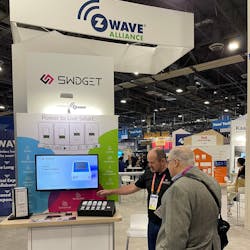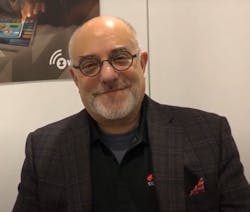This article originally appeared in the February 2023 issue of Security Business magazine. When sharing, don’t forget to mention Security Business magazine on LinkedIn and @SecBusinessMag on Twitter.
When Alarm.com unveiled its new Water Dragon home water protection solution at CES 2023, it became one of the first products to leverage the new Z-Wave Long Range (LR) protocol, joining fellow Z-Wave Alliance companies Zooz, The Smartest House, and Ecolink as early adopters of the certification introduced in 2022.
Z-Wave LR extends Z-Wave connectivity beyond the interior boundaries of the home to improve wireless transmission range of peripheral Z-Wave devices such as door locks, garage door sensors, gate access solutions, and more, while increasing scalability to over 4,000 nodes on a single smart home network.
“What Z-Wave Long Range enables you to do is get upwards of a mile or more in terms of distance between your long-range product and your main system,” Mitchell Klein, Executive Director of the Z-Wave Alliance, explained at their CES 2023 booth. “In terms of practical use cases, a perfect example would be door locks out on the fringe of a property – pool houses, mailboxes – and even large homes getting from one end to another.”
Another primary application of Z-Wave LR would be in the multi-dwelling unit (MDU) space, such as rental apartment buildings with 100-plus“Long range enables the distance and also enables larger quantities,” Klein explained “Whereas Z-Wave typically enables about 252 products per system, Z-Wave Long Range enables upwards of 4,000 devices into a single system. So when you're looking at an MDU and working with a property manager, using door locks as an example, being able to lock or unlock the door to one of the apartments to enable someone to go show it; or activating thermostats or lights; we find that our members find this larger quantity to be a very attractive opportunity.”
Will Competing Standards Matter?
The Z-Wave Pavilion – which featured 13 different partner companies at CES 2023 – has long been a fixture on the show floor at CES; however, the push for smart home device standardization has seen more entrants into this space, including the much-ballyhooed Matter standard, a product of collaboration between the biggest tech heavyweights around – Amazon, Apple, Google and the list goes on.
Is this friendly competition a good thing? Klein thinks so.
“First of all, we are very supportive of Matter, even if it has gotten enormous press and media attention,” Klein says. “Whenever you get companies like Amazon and Apple and Samsung to all agree on something, that is big news, and I will acknowledge that. But I'm actually really happy about it and really supportive of it.
Now we've got all these large and small companies in the CSA all saying interoperability matters…well you know what? We have been saying that for 20 years, so it is really nice that someone else is saying interoperability is important,” Klein added. “Another aspect for why we're really supportive of Matter is that we recognize that if a technology were to come out that made all of the hundreds of millions of existing products in the marketplace, become dark and would no longer work, that would not be very successful initiative. The development and the platform for Matter always had the intention to put hooks in with the intention of making them compatible or interoperable with other platforms.”
Klein says he tells Z-Wave Alliance members to continue to build Z-Wave enabled products, because he anticipates a “bridge” that will enable all of them to interact with Matter once it fully rolls out.
“At the time when it is right for the consumer, or for a company to deploy Matter products, it will be fully compatible with existing products in the marketplace,” Klein explained. “Essentially, it means that a Z-Wave product will look like a Matter device.”
So with the amount of competing interoperability protocols in the smart home – from Z-Wave to Matter to Zigbee and beyond – is there a fight for dominance on the horizon? Klein says there is absolutely room for them all.
“The reality is that different technologies exist because certain ones are fit for certain purposes,” Klein said. “If a company comes to me and asks if Z-Wave is the right product for [them], it is not an automatic yes. Technology needs to be fit for a purpose. We already know Z-Wave is very dominant in the security industry, because it's a secure product. It has never been hacked outside of a lab. The security companies have adopted it, and that's not going away. It is pretty clear that Z-Wave is not going away. What is going to be really important is the bridging or the interoperability between existing products and Matter. At some point, when Matter does become successful and gets more widely adopted – and I expect it will be – its real purpose is to enable consumers to buy devices that will automatically work with each other.
“We want to make sure that it will be compatible with all the products that security dealers are using,” Klein added. “Z-Wave is going to continue to be an installer-focused product category; Matter will be more consumer-focused, and there will be a bridge in between.”
Paul Rothman is Editor-in-Chief of Security Business magazine, a printed partner publication of SecurityInfoWatch.com. Access the current issue, archives and subscribe at www.securitybusinessmag.com.
Watch the full interview with Mitch Klein: https://youtu.be/JaMAsJZ-Au4.
Also check out our CES interview with Resideo discussing the Matter protocol: https://youtu.be/IVSRh8OGM8M




